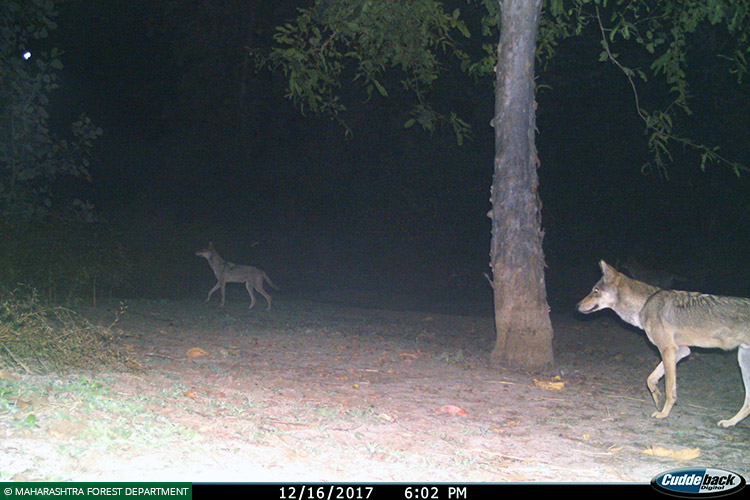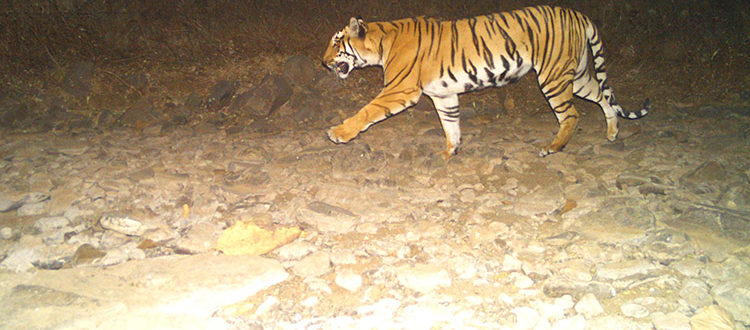Call of the Wild
By Nikhil Dandekar
[acx_slideshow name=”Vidarbha Wolves 28012018″]
“Khyak…. khyak…. khakarrrrr khak” – the sound echoed through the forest. Having wandered the tiger forests of India for several years, I knew exactly what it meant. But we were certainly not ready for a tiger sighting, not at that moment!
Tracking wild animals, especially large carnivores, outside protected forests is not easy. Animals survive and thrive in such landscapes only because they know how to avoid humans. One’s task is even more challenging when it comes to tracking a specific individual that has caused conflict, but monitoring patterns of movement is a vital first step in preventing human or cattle casualties. Of course, while tracking an animal’s movements there is every possibility that one might actually stumble upon it!
In one recent case WTI’s Vidarbha Tiger Project team was tracking a tigress that had killed four people over a period of four months. We were working with frontline staff of the Maharashtra Forest Department’s Territorial and FDCM Division, who had never seen a tiger in their area! The operation spanned a vast landscape and camera traps had been placed at strategic locations. They had to be checked regularly to get leads about the tiger’s movements.
This was one such day and we were checking the camera traps along with forest department staff. It was our usual drill: heading into the forest, checking the roads and pugmark impression pads, and then checking the camera traps for images. We reached a camera placed near the live bait that we had tied to lure the tiger, when, before I could remove the memory card, I heard a langur alarm call! Now langur calls are among the best indicators when one is tracking tigers, so this one definitely got my attention. But langurs also sound the alarm when they see humans in the vicinity, so I wasn’t overly perturbed.
As I reached out for the camera trap the entire troop of langurs began calling out in a frenzy. My heartbeat went from Fiat to Ferrari in three seconds.
As I reached out for the camera again, however, the entire troop of langurs began calling out in a frenzy. My heartbeat went from Fiat to Ferrari in three seconds. Call after call broke the silence of the jungle. We hadn’t heard alarm calls in this area in the past three months and I knew only the presence of a wild predator could have triggered such a panic among the langurs.
It was early morning and we were deep inside the forest at least 100 metres away from our vehicle – and close to the live bait. We were certainly not expecting to sight a tiger that no one had seen in the flesh, even after tracking it for more than three months! Excitement, adrenaline and tension rushed through our veins. We started walking towards a small hill, hoping to get a better vantage to sight the most charismatic mammal in India. That 50 metre walk would have taken usually 30 seconds but it seemed like ages. My mind was already calculating our options: ‘What if it really is the tiger we’re tracking? What if it is walking towards us? Will we have time to get to the vehicle? Is there a tall tree we can climb? Is everyone brave enough to stand their ground until the tiger walks away?’ A drop of sweat rolled down my face on that cold winter morning. Our steps were progressively slower as we moved towards the alarm calls. The slightest rustle of leaves caused us to jerk our heads in the direction of the sound.
‘Look there it is! Wait… what? No! There’s another one! The third one just crossed that tree. And there goes the fourth one!’ I couldn’t believe what I was looking at. Wolves! Not just one but four of them, trotting away from us. They glared up at the langurs and disappeared into the undergrowth.
Wolves are among most ignored predators in Indian forests and it is very rare to see them in a tiger dominated landscape. My excitement was obvious though the others could not understand why I was so happy. The camera trap we had gone to check earlier also revealed that a pair of wolves had visited the bait, though it was very much alive.
Seeing a tiger would have certainly made my day but getting to see two pairs of wolves instead? That made my year!

The author is a Field Officer & Biologist with Wildlife Trust of India’s Vidarbha Tiger Project









